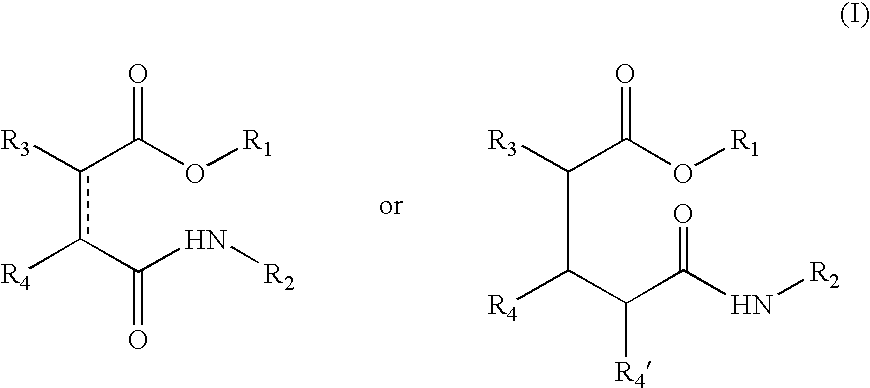Esters comprising a secondary carbamoyl function and their use as odorant alcohol precursors
a carbamoyl function and odorant alcohol technology, applied in the perfume industry, can solve problems such as the effect of perfum
- Summary
- Abstract
- Description
- Claims
- Application Information
AI Technical Summary
Benefits of technology
Problems solved by technology
Method used
Image
Examples
example 1
[0034] Preparation of the Compounds of Formula (I)
[0035] The compounds according to the invention were all prepared by the same general method. For each compound, the type of acid anhydride used, the odoriferous alcohol, the solvent (MTBE: methyl tert-butyl ether, or CH.sub.2Cl.sub.2: dichloromethane), the type of mixed anhydride used, produced using pivaloyl chloride or ethyl chloroformiate, and lastly the selected amine (ammonium acetate, ethyl amine, octyl amine or dodecyl amine, etc.) are specified.
[0036] General Method of Synthesis
[0037] Acid anhydride (1 equivalent) and a perfuming alcohol (1 equivalent, or 2 equivalents if the anhydride is bifunctional, as is the case with pyromellitic anhydride, for example) were dissolved in a solvent (20 ml / mmol anhydride). The mixture was cooled to a temperature of 5.degree. C. to 10.degree. C. before the addition of triethyl amine (1 equivalent, or 2 equivalents in the case of pyromellitic anhydride). The mixture was stirred continuously...
example 2
[0212] Tests for Liberation of the Odoriferous Alcohols in a Basic Medium
[0213] A plurality of tests were carried out at pH 7.6 and pH 10.2 on compounds according to the invention to control the hydrolysis of the ester function by the following general method.
[0214] General Method
[0215] General points: At t=0, 1 ml of a solution (1.6 mg / ml) of compound according to the invention in acetonitrile was added rapidly to a buffer solution (water / acetonitrile 4:1) at pH 7.6 and pH 10.2 respectively. The buffer solution was prepared by diluting two buffer tablets of phosphate (pH=7.6) or borate (pH=10.2) (Fluka) in a mixture of 160 ml of water and 40 ml of acetonitrile. Hydrolysis was followed by HPLC (high pressure liquid chromatography) at 20.degree. C. until completion of liberation. In this way, using the stated method (HPLC), the hydrolysis of compounds 1 to 36 with liberation of an odoriferous alcohol was tested under the aforementioned pH conditions.
example 3
[0216] Tests on Textiles Using the Linitest Apparatus
[0217] Method for a flannel: a weighed flannel (28 cm.times.28 cm, approximately 36 g) was placed in a 600 ml stainless steel container with 1.8 g of standard detergent (Henkel, ECE Colour Fastness Test Detergent 77) and 400 ml of water. The container was agitated in a Linitest rotary water bath at 42.degree. C. for 20 minutes. The flannel was then rinsed twice with 600 ml of water. The softening rinse was carried out with 600 ml of water containing 1.8 g of softening base concentrated three times (reference 91 / 28 composition given below, example 3). This base contained 0.8% by weight of perfume precursor or the corresponding free alcohol in an equimolar quantity. The flannel was then wrung by hand to a constant weight (70 g-75 g). Flannels treated with each precursor and those treated with the corresponding perfuming alcohol were compared olfactorily by a panel of 4 people after different drying times in the open air. It was thus...
PUM
| Property | Measurement | Unit |
|---|---|---|
| temperature | aaaaa | aaaaa |
| pH | aaaaa | aaaaa |
| pH | aaaaa | aaaaa |
Abstract
Description
Claims
Application Information
 Login to View More
Login to View More - R&D
- Intellectual Property
- Life Sciences
- Materials
- Tech Scout
- Unparalleled Data Quality
- Higher Quality Content
- 60% Fewer Hallucinations
Browse by: Latest US Patents, China's latest patents, Technical Efficacy Thesaurus, Application Domain, Technology Topic, Popular Technical Reports.
© 2025 PatSnap. All rights reserved.Legal|Privacy policy|Modern Slavery Act Transparency Statement|Sitemap|About US| Contact US: help@patsnap.com



